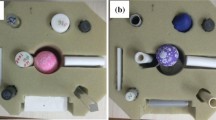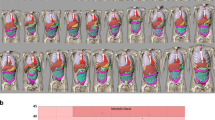Abstract
To develop an algorithm to automatically map CT scan locations of patients onto computational human phantoms to provide with patient-specific organ doses. We developed an algorithm that compares a two-dimensional skeletal mask generated from patient CTs with that of a whole body computational human phantom. The algorithm selected the scan locations showing the highest Dice Similarity Coefficient (DSC) calculated between the skeletal masks of a patient and a phantom. To test the performance of the algorithm, we randomly selected five sets of neck, chest, and abdominal CT images from the National Institutes of Health Clinical Center. We first automatically mapped scan locations of the CT images on a computational human phantom using our algorithm. We had several radiologists to manually map the same CT images on the phantom and compared the results with the automated mapping. Finally, organ doses for automated and manual mapping locations were calculated by an in-house CT dose calculator and compared to each other. The visual comparison showed excellent agreement between manual and automatic mapping locations for neck, chest, and abdomen-pelvis CTs. The difference in mapping locations averaged over the start and end in the five patients was less than 1 cm for all neck, chest, and AP scans: 0.9, 0.7, and 0.9 cm for neck, chest, and AP scans, respectively. Five cases out of ten in the neck scans show zero difference between the average manual and automatic mappings. Average of absolute dose differences between manual and automatic mappings was 2.3, 2.7, and 4.0% for neck, chest, and AP scans, respectively. The automatic mapping algorithm provided accurate scan locations and organ doses compared to manual mapping. The algorithm will be useful in cases requiring patient-specific organ dose for a large number of patients such as patient dose monitoring, clinical trials, and epidemiologic studies.



Similar content being viewed by others
References
Miglioretti DL, Johnson E, Williams A, Greenlee RT, Weinmann S, Solberg LI, Feigelson HS, Roblin D, Flynn MJ, Vanneman N, Smith-Bindman R: The use of computed tomography in pediatrics and the associated radiation exposure and estimated cancer risk. JAMA Pediatr 167(8):700–707, 2013
Smith-Bindman R, Miglioretti DL, Johnson E, Lee C, Feigelson HS, Flynn M, Greenlee RT, Kruger RL, Hornbrook MC, Roblin D, Solberg LI, Vanneman N, Weinmann S, Williams AE: Use of diagnostic imaging studies and associated radiation exposure for patients enrolled in large integrated health care systems, 1996-2010. J Am Med Assoc 307(22):2400–2409, 2012. https://doi.org/10.1001/jama.2012.5960
NCRP: Ionizing radiation exposure of the population of the United States. Bethesda: National Council on Radiation Protection and Measurement, 2009
Harvey HB, Pandharipande PV: The federal government’s oversight of CT safety: regulatory possibilities. Radiology 262(2):391–398, 2012. https://doi.org/10.1148/radiol.11111032
McCollough C et al.: The measurement, reporting, and management of radiation dose in CT. Rep AAPM Task Group 23:1–34, 2008
AAPM: Size-specific dose estimates (SSDE) in pediatric and adult body CT examinations 2011
Simon SL, Kleinerman RA, Ron E, Bouville A: Uses of dosimetry in radiation epidemiology. Radiat Res 166(1 Pt 2):125–127, 2006. https://doi.org/10.1667/RR3385.1
Samei E, Tian X, Segars WP: Determining organ dose: the holy grail. Pediatr Radiol 44(S3):460–467, 2014. https://doi.org/10.1007/s00247-014-3117-7
Ding A et al: VirtualDose: a software for reporting organ doses from CT for adult and pediatric patients, 5601–5625, 2015, https://doi.org/10.1088/0031-9155/60/14/5601.
Lee C, Kim KP, Bolch WE, Moroz BE, Folio L: NCICT: a computational solution to estimate organ doses for pediatric and adult patients undergoing CT scans. J Radiol Prot 35(4):891–909, 2015. https://doi.org/10.1088/0952-4746/35/4/891
ImPACT, ImPACT CT Patient Dosimetry Calculator, London, UK 2011.
Kalender WA, Schmidt B, Zankl M: A PC program for estimating organ dose and effective dose values in computed tomography. Eur Radiol 9(3):555–562, 1999. https://doi.org/10.1007/s003300050709
Sahbaee P, Segars WP, Samei E: Patient-based estimation of organ dose for a population of 58 adult patients across 13 protocol categories. Med Phys 41(7):072104, 2014. https://doi.org/10.1118/1.4883778
Stamm G, Nagel HD: CT-expo--a novel program for dose evaluation in CT. RoFo 174(12):1570, 2002
Cristy M: Mathematical phantoms representing children of various ages for use in estimates of internal dose. Oak Ridge: Oak Ridge National Laboratory, 1980
Xu XG: An exponential growth of computational phantom research in radiation protection, imaging, and radiotherapy: a review of the fifty-year history.R233–R302 2014 https://doi.org/10.1088/0031-9155/59/18/R233
Lee C, Lee C, Staton RJ, Hintenlang DE, Arreola MM, Williams JL, Bolch WE: Organ and effective doses in pediatric patients undergoing helical multislice computed tomography examination. Med Phys 34(5):1858–1873, 2007
Lee C, Kim KP, Long D, Fisher R, Tien C, Simon SL, Bouville A, Bolch WE: Organ doses for reference adult male and female undergoing computed tomography estimated by Monte Carlo simulations. Med Phys 38(3):1196–1206, 2011
Dabin J, Mencarelli A, McMillan D, Romanyukha A, Struelens L, Lee C: Validation of calculation algorithms for organ doses in CT by measurements on a 5 year old paediatric phantom. Phys Med Biol 61(11):4168–4182, 2016. https://doi.org/10.1088/0031-9155/61/11/4168
Kim KP, Berrington de Gonzalez A, Pearce MS, Salotti JA, Parker L, McHugh K, Craft AW, Lee C: Development of a database of organ doses for paediatric and young adult CT scans in the United Kingdom. Radiat Prot Dosim 150(4):415–426, 2012. https://doi.org/10.1093/rpd/ncr429
Pokora R et al.: Computed tomography in Germany. Dtsch Arztebl Int 113:1–9, 2016. https://doi.org/10.3238/arztebl.2016.0
Olerud HM et al: Reconstruction of paediatric organ doses from axial CT scans performed in the 1990s – range of doses as input to uncertainty estimates, Eur Radiol, 1–8,2016 https://doi.org/10.1007/s00330-015-4157-6
Bahadori A, Miglioretti D, Kruger R, Flynn M, Weinmann S, Smith-Bindman R, Lee C: Calculation of organ doses for a large number of patients undergoing CT examinations. Am J Roentgenol 205(4):827–833, 2015. https://doi.org/10.2214/AJR.14.14135
Lee C, Flynn MJ, Judy PF, Cody DD, Bolch WE, Kruger RL: Body size–specific organ and effective doses of chest CT screening examinations of the National Lung Screening Trial. Am J Roentgenol 208(5):1082–1088, 2017. https://doi.org/10.2214/AJR.16.16979
G. Kuzmin et al: A novel method to extend a partial-body CT for the reconstruction of dose to organs beyond the scan range, Radiat Res 2018
Lee C, Lodwick D, Hurtado J, Pafundi D, Williams JL, Bolch WE: The UF family of reference hybrid phantoms for computational radiation dosimetry. Phys Med Biol 55(2):339–363, 2010
Lee C, Kim KP, Long DJ, Bolch WE: Organ doses for reference pediatric and adolescent patients undergoing computed tomography estimated by Monte Carlo simulation. Med Phys 39(4):2129–2146, 2012. https://doi.org/10.1118/1.3693052
Geyer AM et al: The UF/NCI family of hybrid computational phantoms representing the current US population of male and female children, adolescents, and adults--application to CT dosimetry. 5225–5242,2014
Funding
This work was funded by the intramural program of the National Institutes of Health, National Cancer Institute, Division of Cancer Epidemiology and Genetics.
Author information
Authors and Affiliations
Corresponding author
Ethics declarations
Disclaimer
The contents are solely the responsibility of the authors and does not necessarily represent the official views of the National Institutes of Health.
Rights and permissions
About this article
Cite this article
Lee, C., Kuzmin, G.A., Bae, J. et al. Automatic Mapping of CT Scan Locations on Computational Human Phantoms for Organ Dose Estimation. J Digit Imaging 32, 175–182 (2019). https://doi.org/10.1007/s10278-018-0119-2
Published:
Issue Date:
DOI: https://doi.org/10.1007/s10278-018-0119-2




